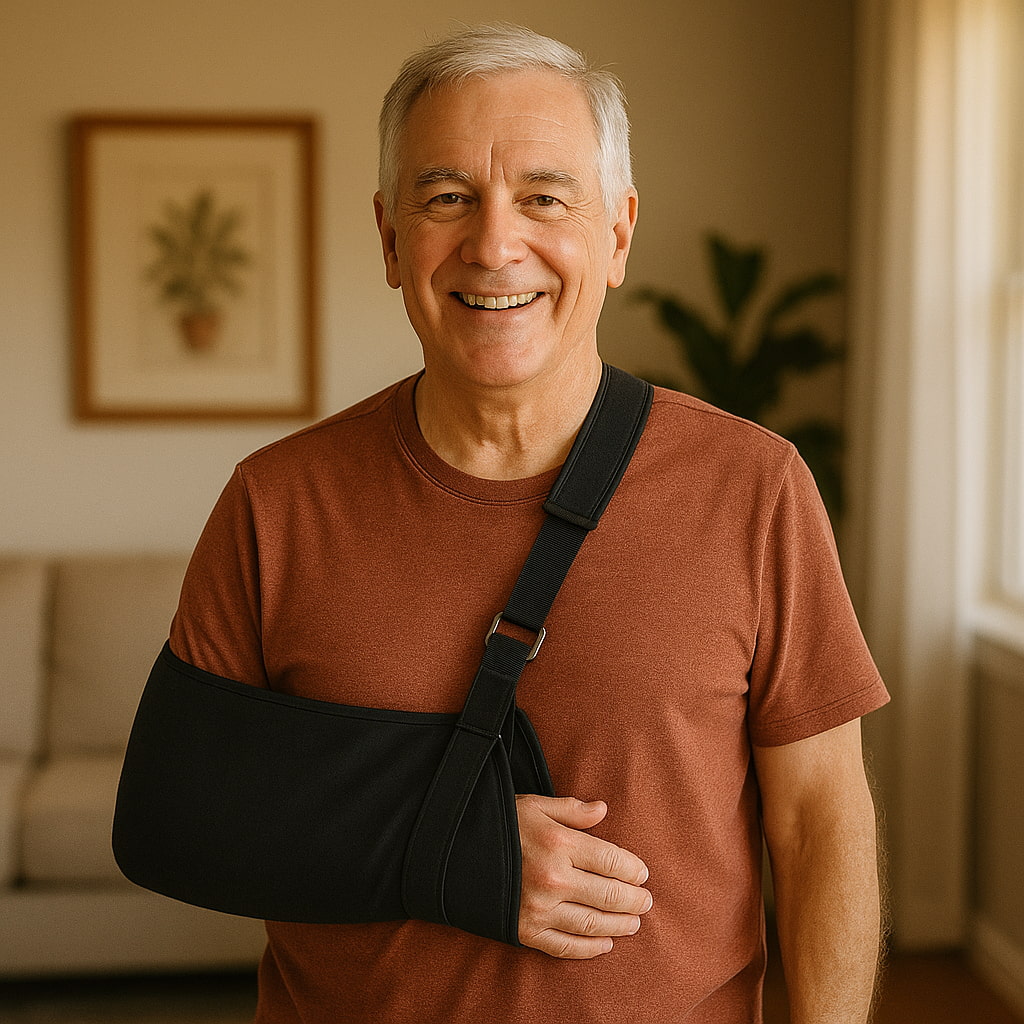See Also
Rehabilitation Goals
- Protect the surgical repair
- Minimize pain and swelling
- Restore passive and active range of motion
- Regain strength and function
- Return to daily activities safely
Expected Recovery Time
| Milestone | Timeframe |
| Sling use (night only), passive exercises | 0-4 weeks |
| Full passive range of motion | 8-12 weeks |
| Begin strengthening exercises | 10-12 weeks |
| Return to most daily activities | 3-4 months |
| Return to recreational sports | 6-12 months |
| Full recovery | 12 months |
Sling Instructions
- The sling is very important to use all day and night while any local anaesthetic wears off in the first 48-72 hours after surgery.
- After that point if you are comfortable you are encouraged not to wear a sling during the day to allow movement to begin
- Take note of the external rotation instructions below which must be followed when coming out of the sling
- Use the sling during sleep for the first 4 weeks in case of any abnormal movements
- If you can sleep and rest with a pillow placed behind your elbow to push it forward this is a safer position for dislocation risk than letting it fall back (rearward)
- For the first 4 weeks use the sling when travelling outdoors to let others know you have a sore shoulder
- There should be no further use of a sling at all after 4 weeks
- Do not lift anything heavy (no more than 500g; e.g. a cup of tea or a can of soft drink) with or without the sling for the first 6 weeks
- Please note these instructions only apply to an Anatomic Total Shoulder Replacement
- For sling instructions following an Reverse Total Shoulder Replacement see here
External Rotation
- The subscapularis tendon is a rotator cuff muscle at the front of the shoulder joint that is detached and then repaired back to allow surgery to occur
- Healing the tendon is critical for a successful outcome in terms of shoulder strength, function and joint stability
- To avoid unnecessary tension on the repaired tendon the following is advised:
- 0-4 weeks: external rotation to 30 degrees only, stopping if painful
- 4-6 weeks: up to 45 degrees, stopping if painful
- 6-12 weeks: up to 60-70 degrees
- Strengthening can begin from 8-10 weeks onwards but starts with isometric work
- Full healing takes approximately 3 months
- Recovery should be guided by a physiotherapist
Phase 1: Early Post-op (0-2 weeks)
Goals
- Protect surgical repair
- Control pain and swelling
- Begin gentle passive motion
- Prevent stiffness in nearby joints
Instructions
- Apply ice to shoulder 15-20 minutes every 2 hours as needed for swelling.
- Keep surgical wound clean and dry.
- Do not lift objects or bear weight through the surgical arm.
Exercises
- Hand, wrist, and elbow range of motion (e.g. fist making, wrist flexion/extension)
- Pendulum exercises (small circles)
- Passive shoulder forward elevation (with therapist or assistance)
- Passive external rotation (up to 30 degrees, stopping if painful)
- Scapular retraction and depression exercises
Phase 2: Protected Passive Motion (2-6 weeks)
Goals
- Maintain healing
- Gradually increase passive range of motion
- Continue to control pain and swelling
Instructions
- Avoid reaching behind the back or heavy lifting
- Ice as needed
Exercises
- Continue Phase 1 exercises
- Passive and assisted forward elevation and external rotation
- Begin gentle isometric exercises (without resistance): deltoid, biceps, triceps
- Scapular stabilization exercises
Phase 3: Active Motion (6-12 weeks)
Goals
- Progress to active range of motion
- Improve shoulder mobility
- Begin light functional use of arm
Instructions
- Avoid lifting objects heavier than 1-2 kg
- No forceful stretching or aggressive motion
Exercises
- Active-assisted range of motion progressing to active motion in all planes
- Continued scapular stabilization
- Begin light closed-chain exercises (table slides, wall walks)
- Continue isometric strengthening
Phase 4: Strengthening (12-24 weeks)
Goals
- Build strength and endurance
- Improve functional activities
- Normalize shoulder mechanics
Instructions
- Gradual return to normal daily activities
- Avoid heavy or overhead lifting until cleared
Exercises
- Progressive resistance training with elastic bands or light weights
- Scapular and rotator cuff strengthening
- Proprioception and coordination drills
- Functional movement exercises
Phase 5: Advanced Strengthening and Return to Activity (6-12 months)
Goals
- Restore full strength
- Safely return to recreational and sports activities
- Maintain shoulder health
Instructions
- Progress activities as tolerated under guidance
- Avoid high-impact activities unless cleared by surgeon
Exercises
- Advanced strengthening routines
- Sport- or occupation-specific drills
- Maintenance flexibility program
- Continue proprioceptive training
When to Contact Your Surgeon
- Fever above 38°C
- Redness, drainage, or swelling around the incision
- Persistent or increasing pain unrelieved by medication
- Numbness, tingling, or weakness in the arm or hand
- Unusual clicking or instability in the shoulder
- Any concerns regarding wound healing or function
Disclaimer
This is a general guideline. Your physiotherapist or Dr Lambers may adjust the protocol based on your specific condition and progress.
